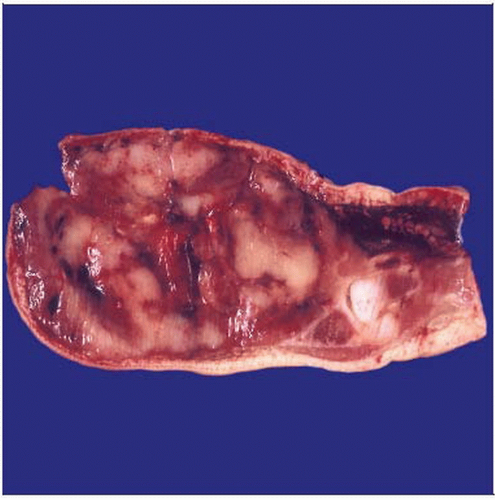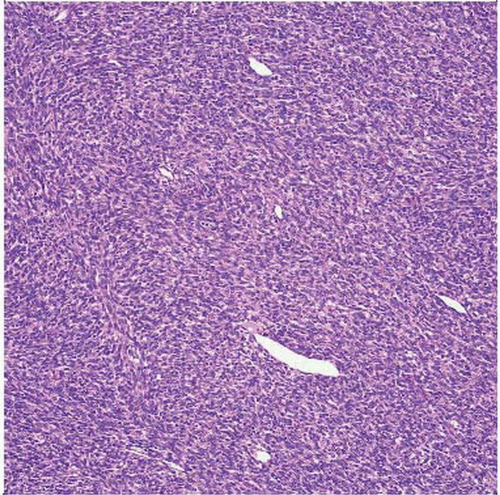Infantile Fibrosarcoma
Thomas Mentzel, MD
Key Facts
Terminology
Occurs in infants and young children; represents low-grade fibrosarcoma that carries favorable prognosis
Clinical Issues
Congenital or arises in 1st two years of life
Superficial and deep soft tissues of extremities are most common sites
Solitary neoplasms
Usually very large neoplasms
Recurrence rate varies (5-50%)
Metastases very rare
Favorable prognosis
Complete excision with tumor-free margins
Microscopic Pathology
Cellular neoplasms
Composed of intersecting fascicles of primitive, immature tumor cells
Usually little cellular pleomorphism
Numerous mitoses
Areas of tumor necrosis &/or hemorrhages are frequent
Often prominent vessels with hemangiopericytoma-like pattern
Primitive ovoid and spindled tumor cells
Ancillary Tests
Most cases contain chromosomal translocation t(12;15)(p13;q26)
NTRK3-ETV6 fusion
 Gross photograph shows a large, hemorrhagic, congenital soft tissue neoplasm arising on the arm of a 13-day-old female baby. |
TERMINOLOGY
Synonyms
Congenital fibrosarcoma
Juvenile fibrosarcoma
Aggressive infantile fibromatosis
Definitions
Occurs in infants and young children and represents a low-grade fibrosarcoma that carries favorable prognosis
CLINICAL ISSUES
Epidemiology
Incidence
Accounts for ˜ 12% of mesenchymal malignancies in infants
Age
Congenital or in 1st 2 years of life
Rare in children older than 2 years
Gender
Slight male predominance
Site
Superficial and deep soft tissues of extremities are most common sites
More rarely seen on trunk and in head and neck region
Very rare in retroperitoneum and in mesentery
Presentation
Limb enlargement
Painless mass
Solitary neoplasms
Usually very large neoplasms
Overlying skin may be ulcerated
Suddenly enlarging mass
Natural History
Often short preoperative duration
Treatment
Surgical approaches
Complete excision with tumor-free margins
Adjuvant therapy
Chemotherapy has been proven effective
Prognosis
Recurrence rate varies (5-50%)
Metastases are very rare
Mortality ranges from 5-25%
Spontaneous regression has been reported
Favorable prognosis
IMAGE FINDINGS
General Features
Usually large soft tissue mass
Shows heterogeneous enhancement pattern
May show osseous erosion
MACROSCOPIC FEATURES
General Features
Poorly circumscribed, lobulated soft tissue tumor
Infiltration of adjacent tissues
Firm gray-white cut surfaces
Variable myxoid changes
Areas of hemorrhage and necrosis are sometimes present
MICROSCOPIC PATHOLOGY
Histologic Features
Cellular neoplasms
Composed of intersecting fascicles of primitive, immature tumor cells
Often sheets of solidly packed, immature, spindled tumor cells
Primitive ovoid and spindled tumor cells
Usually little cellular pleomorphism
Numerous mitoses
Areas of tumor necrosis &/or hemorrhage frequent
Stay updated, free articles. Join our Telegram channel

Full access? Get Clinical Tree



